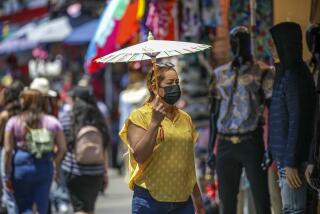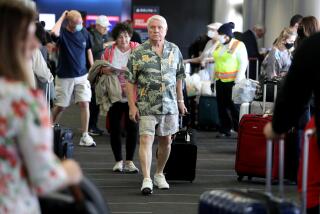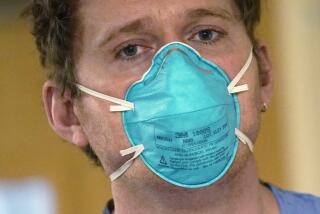Cautionary cover-up
Long a precaution in operating rooms, surgical masks that cover the nose and mouth are now being spotted in airports, markets and schools around the globe, not to mention on mourners at a recent funeral.
Much of the masks’ current visibility can be traced to a mysterious airborne disease that, as of last week, had sickened more than 1,400 people worldwide and killed dozens. The protective mask has become especially prevalent in parts of Asia, where the infection, dubbed severe acute respiratory syndrome, or SARS, originated.
There, even schoolchildren have begun wearing them as a matter of course. And at last week’s burial of a 76-year-old Toronto man who shared a hospital observation room with a SARS patient, grieving relatives wore masks at the urging of local health officials.
The masks have also taken on relevance as the U.S. is forced to confront potential bioterrorism. After the anthrax attacks in October 2001, the U.S. Postal Service and many large companies ordered millions of specialized surgical masks to filter the air their mail-sorting employees breathed. Senate Majority Leader Bill Frist (R-Tenn.) last year advised American families to include such masks in their disaster kits in his book “When Every Moment Counts: What You Need to Know About Bioterrorism From the Senate’s Only Doctor.” The masks, readily available in hardware and medical supply stores, come in various designs and materials, with variable potential to screen out tiny infectious agents. Demand for all varieties has increased in the last month both in this country and overseas, said Jacqueline Berry, a spokeswoman for 3M in St. Paul, Minn., a major manufacturer of the masks.
The kind the Postal Service and many companies bought -- N95 respirator masks with metal clips to fasten securely to the nose -- blocks about 95% of particles that are 0.3 microns in size or larger, which includes anthrax and other infectious agents that might be used as biological weapons. Unfortunately, they’re often hot and make breathing more difficult.
Although less expensive varieties probably aren’t effective against highly infectious biological agents and are probably minimally effective against SARS, they may be “more than sufficient to interrupt the spread of many types of bacterial and viral infections that spread via large droplets,” says Dr. David Pegues, an infectious disease specialist at UCLA. “They are insufficient to fully protect you against things like tuberculosis, which can float in the air, and types of viruses like chicken pox or measles.”
The precedent for self-protection with masks dates to the great influenza pandemic of 1918, when people in the street covered their noses and mouths with fabric. In fact, San Francisco city leaders fined and jailed anyone who wasn’t wearing one.
This time around, official recommendations about mask use in this country are more conservative. The U.S. Centers for Disease Control and Prevention in Atlanta has said that emergency room patients with suspected SARS should be given masks for the benefit of fellow patients and health care workers. The idea is to minimize a patient’s ability to disperse infectious droplets through coughing, sneezing and even speaking.
The federal agency has also advised that health care workers, family members and others in close contact with the patient might want to wear a mask. Initially, surgical masks were designed with the ill person in mind: Doctors and nurses wore them to protect patients from their germs during operations. The masks kept health care workers from “breathing onto and drooling onto the patient,” said Dr. Keith Beck, an infectious disease specialist at Harbor-UCLA Medical Center in Torrance.
When the goal is to contain infection, however, Beck said it’s preferable to put the mask on the patient because it catches microbe-loaded droplets that would otherwise be spewed into the air.
Mask-wearing is a cultural phenomenon in Asia, where it’s considered impolite to infect others with a cold or other illness. This custom has been carried over by some Asian immigrants in this country, who sometimes wear surgical masks when venturing into shops or other public places.
Dr. Laurene Mascola, chief of acute communicable disease control for the L.A. County Department of Health Services, said that in the U.S., where cases of SARS have been mild so far, she doesn’t see a need for the general public to suddenly stock up on surgical masks.
However, she understands why so many people in Hong Kong have been wearing them.
“Hong Kong is a tiny place. They really have crowding. You’re having intimate contact with people if you don’t have a mask on.”
More to Read
Sign up for Essential California
The most important California stories and recommendations in your inbox every morning.
You may occasionally receive promotional content from the Los Angeles Times.










